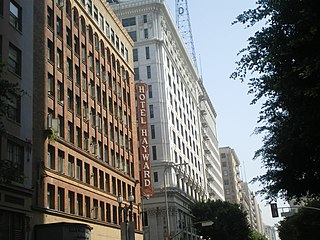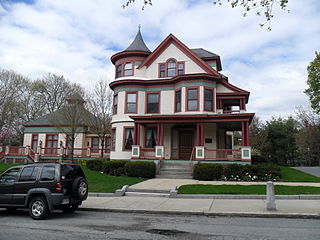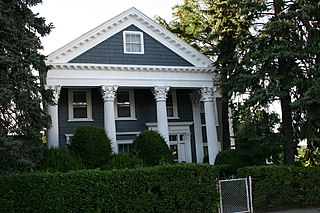
The Main Street Historic District encompasses the historic commercial center of Middletown, Connecticut, United States. Middletown was one of the most important ports on the Connecticut River during the colonial period, and Main Street "has been the center of community life since the earliest period of settlement". Today Main Street is home to a number of 19th century buildings, maintaining the bulk of its historic character. It was listed on the National Register of Historic Places in 1983.

The Abbott Street School is a historic school building at 36 Abbott Street in Worcester, Massachusetts. Built in 1894, it is a good local example of Romanesque Revival architecture. It served as a public school until 1981, after which it was converted to residential use. The building was listed on the National Register of Historic Places in 1980.

The Main Street Historic District in Danbury, Connecticut, United States, is the oldest section of that city, at its geographical center. It has long been the city's commercial core and downtown. Its 132 buildings, 97 of which are considered contributing properties, include government buildings, churches, commercial establishments and residences, all in a variety of architectural styles from the late 18th century to the early 20th. It is the only major industrial downtown of its size in Connecticut not to have developed around either port facilities or a water power site.

The Main Street Historic District encompasses the historic late 19th and early 20th-century commercial heart of Webster, Massachusetts. It consists of fourteen buildings on Main Street in downtown Webster, between High and Church Streets. This area contains the highest concentration of period commercial buildings in the town. The district was listed on the National Register of Historic Places in 1982.

The Monument Park Historic District is a historic district centered on Monument Park in downtown Fitchburg, Massachusetts. The district has one of the city's finest assemblages of high-quality architecture, including a number of civic, religious, and commercial buildings near the park. The district was listed on the National Register of Historic Places in 1978.

Spring Street in Los Angeles is one of the oldest streets in the city. Along Spring Street in Downtown Los Angeles, from just north of Fourth Street to just south of Seventh Street is the NRHP-listed Spring Street Financial District, nicknamed Wall Street of the West, lined with Beaux Arts buildings and currently experiencing gentrification. This section forms part of the Historic Core district of Downtown, together with portions of Hill, Broadway, Main and Los Angeles streets.

The Hampden Savings Bank building is a historic bank building at 1665 Main Street in Springfield, Massachusetts. The building's original tenant, Hampden Bank, now has a headquarters several blocks south of this site at 19 Harrison Avenue. The Classical Revival building was designed by Max H. Westhoff for the bank in 1918. The building was listed on the National Register of Historic Places in 1983.

The G.A.R. Hall, formerly the Bull Mansion, is a historic Grand Army of the Republic Hall at in Worcester, Massachusetts. It is an ornate Victorian Gothic/Stick style two-story granite structure, designed by noted New York City architect Calvert Vaux. The building was listed on the National Register of Historic Places in 1975.

The Worcester Five Cents Savings Bank is a historic bank building at 316 Main Street in Worcester, Massachusetts. The six story Romanesque Revival building was constructed in 1891 to a design by Stephen Earle. The building is unusual in downtown Worcester for its use of limestone and buff brick, and for its rounded corner bay. The building originally had plate glass and iron store fronts on its ground floor, but this was redone in matching limestone sometime after 1949.

The Woodland Street Historic District is a historic housing district in the Main South area of Worcester, Massachusetts. It consists of 19 Victorian houses that either face or abut on Woodland Street, between Charlotte and Oberlin Streets. The district was listed on the National Register of Historic Places in 1980. Located directly adjacent to the campus of Clark University, some of the buildings are used by Clark for housing and administration.

The Waldo Street Police Station is a historic former police station on Waldo Street in Worcester, Massachusetts. Built in 1918 to a design by George H. Clemence, it is a distinctive local example of Renaissance Revival architecture. It served as the city's police headquarters and district until 1980, and now houses commercial tenants. The building, now part of One Exchange Place, was listed on the National Register of Historic Places in 1980.

The WCIS Bank is a historic and unusual bank building at 365 Main Street in Worcester, Massachusetts. It is fashioned out of two separate buildings, each of which has served as a home for the Worcester County Institution for Savings, the county's first chartered savings bank. The older part of the building, from c. 1851, is at the corner of Foster and Norwich Street, and was built as a joint venture between the bank's parent, the Worcester Bank, and the Boston and Worcester Rail Road. It is a granite structure three stories high, decorated in Italianate styling. It originally featured windows with broken-scrolled pediments on the second story, and bracketed flat hoods over the windows on the third story, but these and other details were compromised by stuccoing done in the 1960s.

The Arad Alexander House is a historic house at 53 Waverly Street in Worcester, Massachusetts. Built about 1845 and moved in the 1860s, it is one of the city's most elaborate Greek Revival residences, and may have been designed by prominent local architect Elias Carter. It was listed on the National Register of Historic Places on March 5, 1980.

The Dowley-Taylor House is a historic house at 770 Main Street in Worcester, Massachusetts. Built in 1842 to a design by architect Elias Carter, it is one of the best-preserved high-style Greek Revival mansions in the city. The house was listed on the National Register of Historic Places in 1980.

The Henry Goulding House is an historic house at 26 Harvard Street in Worcester, Massachusetts< USA. Built in 1850-51 for a major local industrialist, it is one of the city's most opulent Italianate houses. In 1921, the house became the Swedish Lutheran Home for the Aged after the Goulding heirs gave it to the Swedish Lutheran Church of Worcester. The house was owned by Lutheran Social Services, Inc. in 1980 when the house was added to the National Register of Historic Places. It is now owned by the Sheehan Health Group and is operated as the Lutheran Rehabilitation & Skilled Care Center.

The Charles Newton House is a historic house at 24 Brattle Street in Worcester, Massachusetts.

Stephen Carpenter Earle was an architect who designed a number of buildings in Massachusetts and Connecticut that were built in the late 19th century, with many in Worcester, Massachusetts. He trained in the office of Calvert Vaux in New York City. He worked for a time in partnership with James E. Fuller, under the firm "Earle & Fuller". In 1891, he formed a partnership with Vermont architect Clellan W. Fisher under the name "Earle & Fisher".

Valparaiso has retained an active downtown. It remains a mix of government, retail and business center, with a mixed residential and service area. Numerous economic changes have not changed the basic character, historic courthouse area. The historic district retains the distinctive turn-of-the-19th-century architecture, supporting numerous small specialty shops, shaded sidewalks, and a people friendly environment. The Downtown District, is anchored on the Porter County Courthouse. It includes 14-blocks surrounding the square, bounded on the north by Jefferson Street, on the east by Morgan Street, on the south by Monroe Street, and on the west by Napoleon Street.

Elbridge Boyden (1810–1898) was a prominent 19th-century American architect from Worcester, Massachusetts, who designed numerous civil and public buildings throughout New England and other parts of the United States. Perhaps his best known works are the Taunton State Hospital (1851) and Mechanics Hall (1855) in Worcester.

The Downtown Waterbury Historic District is the core of the city of Waterbury, Connecticut, United States. It is a roughly rectangular area centered on West Main Street and Waterbury Green, the remnant of the original town commons, which has been called "one of the most attractive downtown parks in New England."























